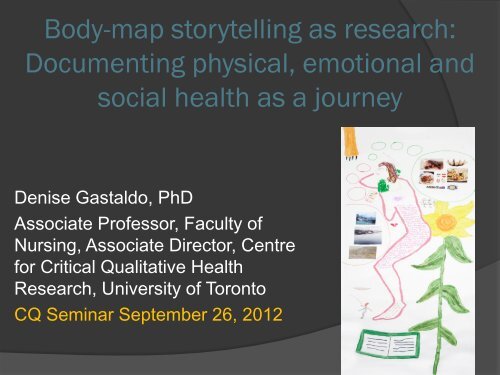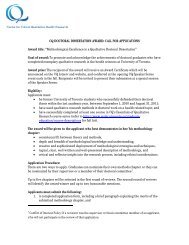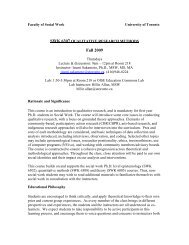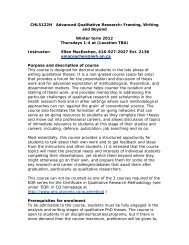Body-map storytelling as research - CQ - University of Toronto
Body-map storytelling as research - CQ - University of Toronto
Body-map storytelling as research - CQ - University of Toronto
- No tags were found...
Create successful ePaper yourself
Turn your PDF publications into a flip-book with our unique Google optimized e-Paper software.
<strong>Body</strong>-<strong>map</strong> <strong>storytelling</strong> <strong>as</strong> <strong>research</strong>:Documenting physical, emotional andsocial health <strong>as</strong> a journeyDenise G<strong>as</strong>taldo, PhDAssociate Pr<strong>of</strong>essor, Faculty <strong>of</strong>Nursing, Associate Director, Centrefor Critical Qualitative HealthResearch, <strong>University</strong> <strong>of</strong> <strong>Toronto</strong><strong>CQ</strong> Seminar September 26, 2012
Publication <strong>Body</strong>-Map Storytelling <strong>as</strong> Researchwww.migrationhealth.ca/undocumentedworkers-ontario/body-<strong>map</strong>ping Entangled in a Web <strong>of</strong> Exploitation andSolidarity (study report)www.migrationhealth.ca/undocumentedworkers-ontario/summary-findings Co-Authors• Denise G<strong>as</strong>taldo, Co-Principal Investigator• Lilian Magalhaes, Co-Principal Investigator• Christine Carr<strong>as</strong>co, Research Coordinator• Charity Davy, Research Assistant
Acknowledgements Research participants, for their generosity andcourage. Community Partners:• Centre for Spanish Speaking Peoples (CSSP)• Centre for Support & Social Integration Brazil-Canada (CAIS) Advisory Board members:• Cathy Tersigni, Community Health Officer, <strong>Toronto</strong> PublicHealth• Jussara Lourenço, Counsellor, St. Christopher House• Gerardo Betancourt, AIDS Community Educator, Centre forSpanish Speaking Peoples• Celeste Joseph, HIV/AIDS Counsellor, Centre for SpanishSpeaking Peoples• Juliana Ferreira, Coordinator, Centre for Support & SocialIntegration Brazil-Canada Study funded by CIHR, Institute <strong>of</strong> Gender and Health
A story about <strong>storytelling</strong> andqualitative <strong>research</strong>
PrinciplesScientific discourse <strong>as</strong> a form <strong>of</strong> literature: mathematics,statistics, descriptions, c<strong>as</strong>e studies, visual studies <strong>as</strong>narrative stylesDoing <strong>research</strong> to understand and potentially change theworld• Science <strong>as</strong> an approach to acquire in-depth understanding• Science <strong>as</strong> a political exerciseDoing <strong>research</strong> to create new ways to think and speakabout a phenomenon (challenge established truths andpromote emergent discourses)• Move away from notions <strong>of</strong> autonomy and agency thatdisregard historical and economic conditions; to make ‘thepersonal’ political and global; to study the SDH
Principles (2)Critically thinking about <strong>storytelling</strong> (Chamberlin, 2004):• If this is your land, where are your stories? (Glitksan elder)• “Conflict is at the heart <strong>of</strong> the way language works, andtherefore the way stories work <strong>as</strong> well” (p.25)• “Just <strong>as</strong> we learn how to read, so we learn how to listen [toother oral traditions]; and this learning does not comenaturally” (p. 21)• Goals: to create a new language to speak about “illegals”, todiminish the gap between “us and them”, to tell stories <strong>of</strong><strong>as</strong>sets and resilience <strong>as</strong> well <strong>as</strong> exploitation• Not an “applied”, “useful” <strong>research</strong> according to the currenthealth care utilitarianist epidemic: perhaps, idle, slow; tellingstories to think differently and find common ground
Context One <strong>of</strong> the effects <strong>of</strong> the intensification <strong>of</strong>globalization in the l<strong>as</strong>t two decades h<strong>as</strong> beena call for the migration <strong>of</strong> cheap, flexible, andmobile labour to high-income countries (theNew South). This phenomenon w<strong>as</strong> notaccompanied by changes in regulatorymigration provisions in host nations, leadinginto the undocumentedness <strong>of</strong> large groups <strong>of</strong>workers who do not have a legal pathway toregularize their status. Health care is not a human right in Canada butrather a documented-citizen right
Challenge – beyond interviews To capture a journey, movement, evolvingsujectivities To help to describe a transnational existence,multiple identities To let the participant narrate experiences in anon-chronological order and from multipleplaces To make these workers visible <strong>as</strong> humanbeings (e.g. dreams, relationships) To facilitate the description <strong>of</strong> physical,emotional and social health
In search <strong>of</strong>… Why use a visual methodology?“(...) we need <strong>research</strong> which is able toget a full sense <strong>of</strong> how people thinkabout their own lives and identities, andwhat influences them and what toolsthey use in that thinking, because thosethings are the building blocks <strong>of</strong> socialchange.” (Gaunlett & Holzwarth, 2006,p.8)
Methodology Study conducted between 2009-2012Participants:• Latin American migrant workers who lived and workedundocumented in the GTA (from 18 months to 10 years)• Diverse occupations• 22 participantsData Generation:• 3 meetings per participant (average 2 hours each), includingsemi-structured interviews and body-<strong>map</strong> <strong>storytelling</strong> (62interviews, 20 body <strong>map</strong>s completed)Data Analysis:• Discourse analysis and visual analysis
What are body <strong>map</strong>s?
Multiple uses (1)The term body <strong>map</strong>ping h<strong>as</strong> been used inthe context <strong>of</strong> occupational health andsafety for almost 50 years <strong>as</strong> a mode <strong>of</strong>participatory <strong>research</strong> and awarenessraising to identify occupational risks,hazards, and dise<strong>as</strong>es that manifest in theworkplace (Keith & Brophy, 2004; Keith,Brophy, Kirby, & Rosskam, 2002).<strong>Body</strong> <strong>map</strong>ping for clinical practice h<strong>as</strong>been used for <strong>map</strong>ping pain,musculoskeletal problems, etc.In therapy, it is a tool for helping clients toexplore particular <strong>as</strong>pects <strong>of</strong> their lives(e.g. who are their support systems, selfimage,etc).Picture – Rural workers <strong>map</strong> signs andsymptoms <strong>of</strong> pesticide poisoning (DanidaUnion Newsletter, 2002, Thailand)
Multiple uses (2)Arts-b<strong>as</strong>ed body <strong>map</strong>pingoriginated in South Africa<strong>as</strong> an art-therapy forwomen living withHIV/AIDS (Devine, 2008;MacGregor, 2009;Weinand, 2006). JaneSolomon (2002) adaptedthis technique anddeveloped a facilitationguide for art-therapy.Picture: Mock body <strong>map</strong>developed by our<strong>research</strong> team to practicethe technique
Artistic use <strong>of</strong> body <strong>map</strong>s
Ipupiara and Ondina,2007Walmor Correa, Brazilian artist
Using body <strong>map</strong>s for<strong>research</strong>
<strong>Body</strong> <strong>map</strong>s <strong>Body</strong> <strong>map</strong>s can be broadly defined <strong>as</strong> life-sizehuman body images created through drawing,painting or other art-b<strong>as</strong>ed techniques to visuallyrepresent <strong>as</strong>pects <strong>of</strong> people’s lives, their bodiesand the world they live in. <strong>Body</strong> <strong>map</strong>ping is a way <strong>of</strong> telling stories, muchlike totems that contain symbols with differentmeanings, but whose significance can only beunderstood in relation to the creator’s overallstory and experience. <strong>Body</strong> <strong>map</strong>s can be created for different purposes,but the ones presented here were conceived forknowledge production and dissemination.
Definition <strong>Body</strong>-<strong>map</strong> <strong>storytelling</strong> is primarily a data generating<strong>research</strong> method used to tell a story that visuallyreflects social, political and economic processes, <strong>as</strong>well <strong>as</strong> individuals’ embodied experiences andmeanings attributed to their life circumstances thatshape who they have become. <strong>Body</strong>-<strong>map</strong> <strong>storytelling</strong>h<strong>as</strong> the potential to connect times and spaces inpeople’s lives that in traditional, linear accounts areseen <strong>as</strong> separate and distal. The final outcome <strong>of</strong> the body-<strong>map</strong> <strong>storytelling</strong>process is a <strong>map</strong>ped story composed <strong>of</strong> 3 elements:• life-size body <strong>map</strong>• testimonio (brief story narrated in first person)• key to describe each visual element <strong>of</strong> the <strong>map</strong>
Rationale for UseThere are particular <strong>as</strong>sumptions about <strong>research</strong>participation <strong>as</strong> an intellectual activity and participants’contribution to <strong>research</strong> that support body <strong>map</strong> <strong>storytelling</strong>.Like other creative visual methodologies, it <strong>of</strong>fersparticipants a means to communicate ide<strong>as</strong>, experiences,meanings, and feelings, acknowledging that there is a needfor reflexivity for the production <strong>of</strong> quality data.Gaunlett & Holzwarth (2006, p. 83-4) state that a creativemethodology “<strong>of</strong>fers a positive challenge to the taken-forgrantedidea that you can explore the social world [by] just<strong>as</strong>king people questions, in language”. The exercise <strong>of</strong>creating an artifact during a few sessions is a prolongedinvitation to think; “people think about things differentlywhen making something, using their hands – it leads to adeeper and more reflective engagement” (Gaunlett &Holzwarth, 2006, p. 89).
Rationale for Use (2)A second <strong>as</strong>sumption that supports body-<strong>map</strong> <strong>storytelling</strong>is that participants are seen on a positive light, <strong>as</strong> peoplewho have a contribution to <strong>of</strong>fer to the social and healthsciences. This is congruent with the principle <strong>of</strong> employing<strong>as</strong>set-b<strong>as</strong>ed methodologies. As <strong>research</strong>ers, we <strong>of</strong>feredparticipants a means to facilitate their reflexive processand be challenged (e.g. questions <strong>as</strong>king for symbols,homework on messages to share with the public);knowing they have a particular form <strong>of</strong> expertise andinterest in sharing their experiences.By bringing the body to the centre <strong>of</strong> this representationalspace, we helped participants engage in a conversationabout experience and perceptions <strong>as</strong> lived in an embodiedmanner, rather than in a temporal or spatial way.
Materials, Place, Time
Guiding Exercises
Key Elements
Challenges Moderator’s artistic skills Participants’ limitations and interest Data generation vs. knowledge translation Duration <strong>of</strong> each session Space to store materials and let body <strong>map</strong>sdry Magazine pictures represent a celebration <strong>of</strong>capitalist consumption, able-bodies, youth,and whiteness Visual analysis
Ethical Concerns re. <strong>Body</strong> Maps Anonymity: some participants wanted to revealtheir identity, others were comfortable withremaining anonymous through the confidentiality<strong>of</strong> the study Confidentiality: In this study, the body <strong>map</strong>s andtestimonios are stripped <strong>of</strong> significant identifiersand, when in doubt, we eliminated information,sometimes losing interesting data (education,pr<strong>of</strong>essions, number <strong>of</strong> children, ages, cities,countries) to protect participants’ identity Ownership: it is important to decide a priori whokeeps the original body <strong>map</strong> at the end <strong>of</strong> theproject
Outcomes – Limited artistic engagement
Outcomes – Arts-oriented participants
Valeria’s body-<strong>map</strong>ped storyI’m Valeria, a cook and a single mom. I have2 children back home. I came here to makemoney to buy a home for us after I saw howmuch money I could save when I worked inthe US. In the first 2 years, I worked 3 jobs, 7days a week, and I slept 3 hours a night. Iw<strong>as</strong> tired all the time and when I w<strong>as</strong> at work,I would even peel potatoes <strong>as</strong>leep! Now, theapartment is finally paid <strong>of</strong>f and I have moneyto go back and get surgery for my varicoseveins. My legs are very swollen because I’mthe only cook for the lunch and dinner shifts.Kitchen work is really hard! You have to lifthuge pans, chop meat and bones, and you dothis all standing up! I believe God h<strong>as</strong> givenme the strength to do this hard work all theseyears. I wish someone would record a day inmy life so that my children could see howmuch their school and our home have reallycost me. Now, my only hope is that mychildren will forgive me for leaving thembehind and that we can live happily togetherin our new home.
AnalysisMapped stories should be analysed in their integrity,which includes the process <strong>of</strong> creating it (verbatim andfieldnotes), the body <strong>map</strong> itself, and the narratives thataccompany it (testimonio and key).The purpose <strong>of</strong> the analysis is not to psychologicallyevaluate the participants through their art, but to gaininsight into certain <strong>as</strong>pects <strong>of</strong> their logic, <strong>as</strong>pirations,desires, material circumstances, and ways <strong>of</strong> handlingparticular issues.Some visual representations <strong>of</strong> physical andpsychosomatic dise<strong>as</strong>es were very helpful to describe ina straight forward manner the health consequences <strong>of</strong>undocumented work.Yet <strong>as</strong> <strong>research</strong>ers, we are confronted with the challenge<strong>of</strong> how to move from a descriptive to a criticalinterpretation <strong>of</strong> <strong>map</strong>ped stories.
Analysis (2) The creation <strong>of</strong> all three elements that compose the<strong>map</strong>ped stories is in itself the first level <strong>of</strong> analysis,an interpretative exercise conducted in partnershipwith the participants. Facilitator and participantdiscuss visual representations <strong>of</strong> ide<strong>as</strong> and creation<strong>of</strong> slogans and jointly interpret what is being saidvisually (e.g. a glossy-magazine picture <strong>of</strong> anexpensive bag may just mean a suitc<strong>as</strong>e fortravelling) or through key words and short sentencesadded to the body <strong>map</strong>. After the body <strong>map</strong> is readythough, an additional level <strong>of</strong> analysis is required.There are several possibilities on how to move intothis second ph<strong>as</strong>e. For example, body <strong>map</strong>s may beanalyzed one by one <strong>as</strong> c<strong>as</strong>es or a comparativestrategy may be employed.
Comparative, descriptive analysisCommonalities: We arecitizens <strong>of</strong> the worldDifferences: Risky andsafe work environments
Analysis (3) Adopting a critical lens from postcolonial theoryhelped us to see participants’ lives <strong>as</strong> highlyentangled in socio-political-economiccircumstances, making us challenge the notion <strong>of</strong>autonomy and decision-making commonly used tosupport policy and legal thought. In terms <strong>of</strong> selfrepresentationissues, participants showedawareness about “talking” to the public anddominant social discourses, such <strong>as</strong> disapproval forsex trade work (e.g. former owner <strong>of</strong> a stripte<strong>as</strong>ebar visually representing herself <strong>as</strong> a smallbusiness owner) or being provocative andpresenting the idea <strong>of</strong> illegality <strong>as</strong> a product <strong>of</strong>capitalist societies, <strong>as</strong> neocolonial relations supportnew forms <strong>of</strong> exploitation.
Analysis (4) Another analytical element to have in mind is how<strong>research</strong>ers think about body <strong>map</strong>s. They can beconsidered <strong>as</strong> an identity card, a fixed description <strong>of</strong>who people are <strong>as</strong> individuals and <strong>as</strong> a collective.Despite the potential use <strong>of</strong> such characterization forknowledge translation, analytically, it is important tounderstand that body <strong>map</strong>s capture a moment inpeople’s lives and <strong>of</strong>fer a picture <strong>of</strong> a given time andlocations, when they are <strong>as</strong>ked to talk about aparticular element <strong>of</strong> their lives, like in our c<strong>as</strong>e, beingan undocumented worker. However, these are peoplein movement, creating and thinking about theirsubjectivities and the health consequences <strong>of</strong> theirwork <strong>as</strong> they interact with the <strong>research</strong>ers. This sense<strong>of</strong> movement and transitory reality should not be lostby the “definite” images body <strong>map</strong>s seem to portray.
The future h<strong>as</strong> already started
Tool for KTESome potential translationaluses <strong>of</strong> body <strong>map</strong>s include:art exhibits, short films,political action, publications,or other creative mediums(e.g. social media).







